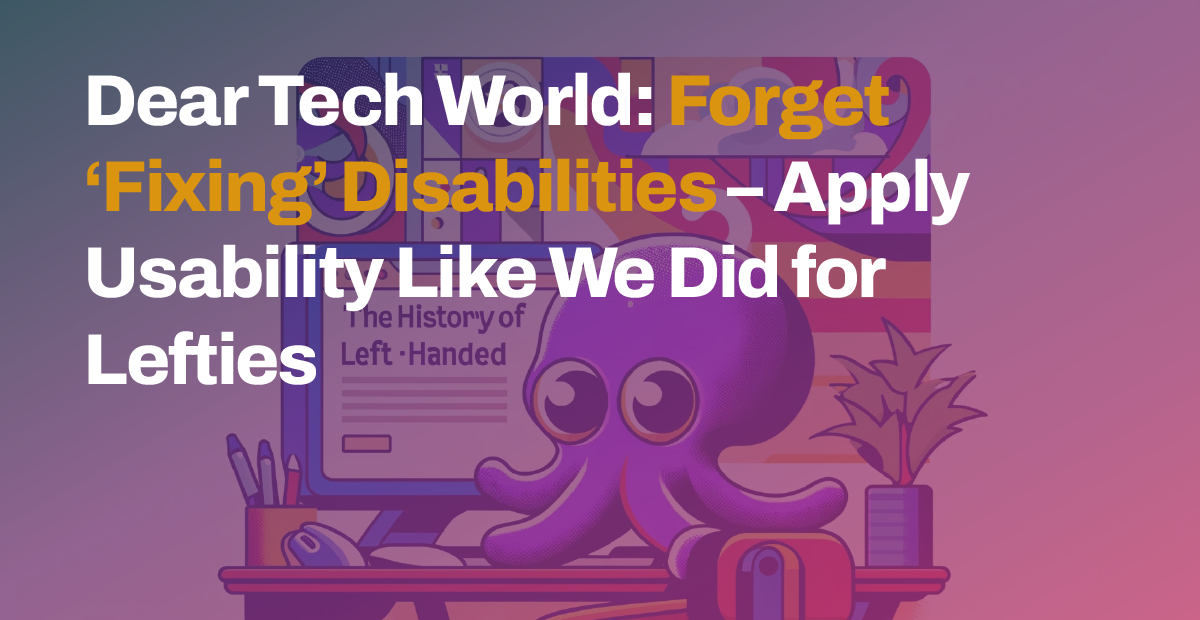Written By: Jason Fields, COO
Tech led the charge in addressing usability for the 10% of the population who are left-handed. It’s time to apply the same approach for the 12% with mobility challenges.
Introduction: The Misguided Notion of ‘Fixing’
I doubt you often notice or care if someone is left-handed. I can name one person who is left-handed: my mom. And that’s only because as a kid, we talked about it (okay, we probably teased her about it—it was the 80s, and I’m not perfect).
Most of you reading this might not recall that being left-handed was an ‘us vs. them’ difference back in the day.
The more extended history will either make you laugh or cry.
Ancient Egypt (circa 3100-30 BCE): Artifacts and records suggest that left-handedness was often viewed with suspicion and associated with bad luck or evil. My mom is not evil…
Medieval Europe (5th-15th Century): Left-handed people were often suspected of witchcraft and sorcery. The left hand was associated with the devil and dark magic.
16th Century: The term “sinister,” derived from the Latin word for “left,” came to mean evil or ominous in many European languages. I’ve known some evil right-handed people in my life.
17th Century: Left-handedness was viewed negatively in Europe, with left-handed people often forced to conform to right-handed norms in schools and society.
19th Century: In the United States and Europe, left-handed children were often punished or forcibly trained to use their right hand for writing and other tasks. This practice was common in schools, where teachers tied students’ left hands behind their backs to enforce right-handed writing.
Early 20th Century
Early 1900-1950s: Left-handedness was still seen as a defect or disability. Medical literature from this period often referred to left-handedness as a “malady” that needed correction. So we move from fear to sympathy… this is one of the 5 steps of grief, no?
Mid to Late 20th Century
1960s: Awareness and understanding of left-handedness began to improve. Researchers and educators started to recognize that left-handedness is a natural variation rather than a defect. So, someone noticed they could still do stuff well?
1969: The American psychologist Stanley Coren published “The Left-Handed Syndrome,” which helped to change public perceptions by discussing the challenges faced by left-handed individuals and advocating for greater acceptance. Go on, Stanley!
Late 20th Century
1980s: The stigma surrounding left-handedness began to fade significantly. Tech companies and manufacturers started producing ambidextrous and left-handed products, reflecting a shift toward inclusivity. And I presume market capture, i.e. revenue… but hey, go tech!
1990s: The left-handed stigma largely disappeared in most Western countries, and left-handedness was widely accepted as a natural variation. Soooo, if my math is right, that was 5,000 years?
21st Century
2000s-Present: Left-handedness is no longer considered a disability or defect. Inclusive design principles have become more prevalent, ensuring products are accessible and usable by left-handed individuals without forcing them to adapt to right-handed norms. Alright, alright, alright.
Lessons from Left-Handed Design
So, how’d we get to this promised land of left-handed usability? It took some ingenuity and commitment I grant you, but it didn’t upend companies or force them out of business.
Apple designed its mouse for ambidextrous use, which is not just good for users but also for manufacturing. Solve a problem in design and save money in production. Gaming companies started introducing customizable controllers, removing the forced button functions, and allowing gamers to map their preferred controls across the device (this seems smart…). Simple tech advancements like this pushed more luddite technology to follow suit like scissors and desks.
And you know what, it worked. A Survey by Logitech in 2018 found that 85% of people using ambidextrous mice reported increased comfort and productivity. Products that used universal design in mind reached 20% more potential customers. In 2017, Razor found that customizable game controllers led to a 30% higher adoption rate among gamers.
Applying it Today: Same Principles, Different Era
Even early tech leaders who adopted universal design principles had a limited view of, or capacity to solve, a UI challenge as varied as disability. Voice commands, customizable buttons, and ambidextrous hardware are great additions and are now commonplace. Yet they don’t address a wider group of people. It’s worth noting that this group isn’t just people with a permanent disability; it includes temporary disabilities (like a broken arm or end-of-day hand fatigue—which I am experiencing right now).
This isn’t a knock-on on Apple, MSFT, Google, etc… We are in a different time at a product level. Tech and digital-first companies have decades of previous design and development that need to be considered with new versions. New tech companies must climb a steep hill to challenge the current leaders, a position that often leaves a more comprehensive usability discussion on the roadmap versus the release schedule. Addressing usability at this scale is daunting and historically promised to be expensive.
For a host of technical reasons I won’t bore you with, today’s digital infrastructure makes it easier than ever for technologies to leverage one another’s functionality. For instance, if you make an iPhone app, you don’t code EVERYTHING; you pull functionality from the library of functions Apple set up and then apply them to the purpose of your app.
Accessibility, ahem, usability is primed to do the same thing. This is what Cephable does with our customers and partners. Rather than starting from scratch to figure out how to interpret head motion, voice/sound, facial expression, and more, they leverage Cephable as a library of functionality applied to their technology’s existing feature sets.
Bonus: Cephable learned from history and is built so that the end user can manage their preferred input mapping, much like early gaming controls. Because not only is there a difference between paraplegia and carpal tunnel, but also how someone feels at different times of the day and what they can do.
Get In Touch
Our team can help you learn more about integrating with Cephable.

